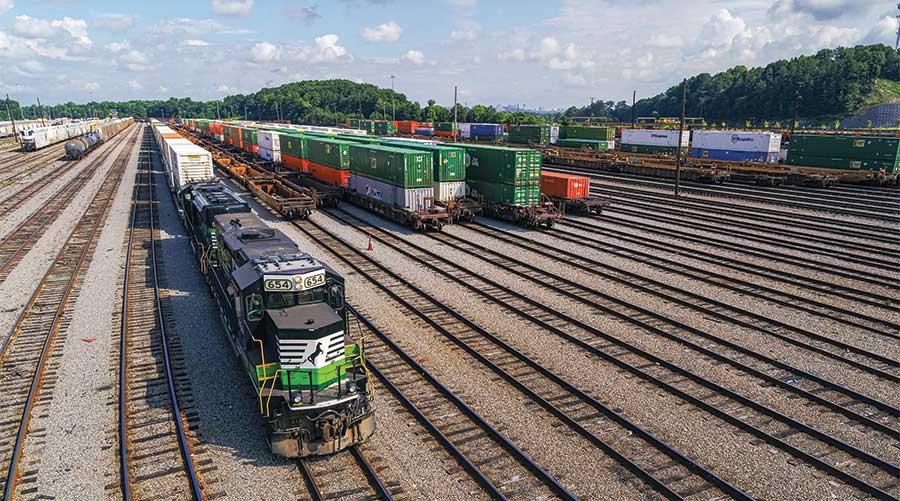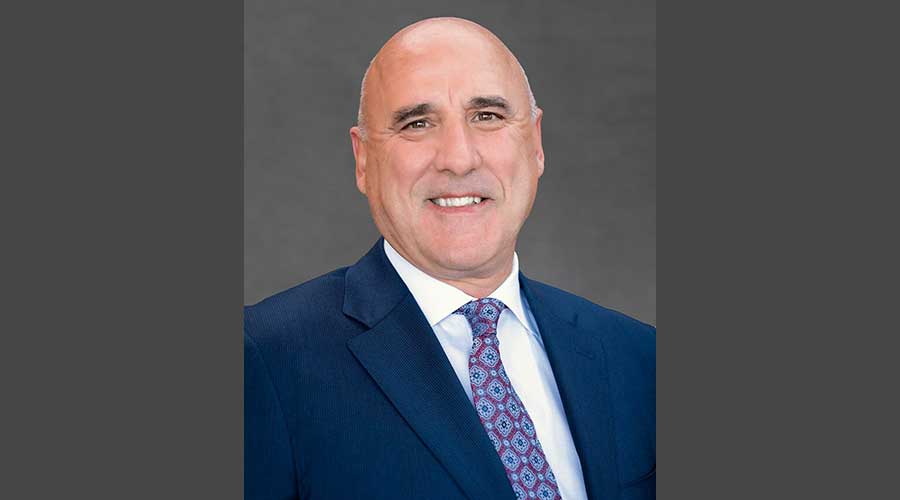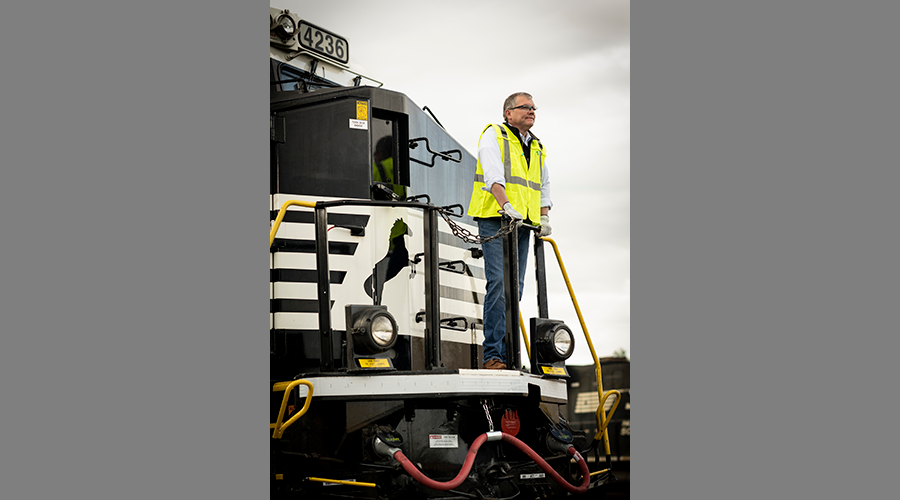Stay updated on news, articles and information for the rail industry
July 2017
Rail News: Norfolk Southern Railway
Norfolk Southern's five-year plan centers on safety, service, stewardship and growth
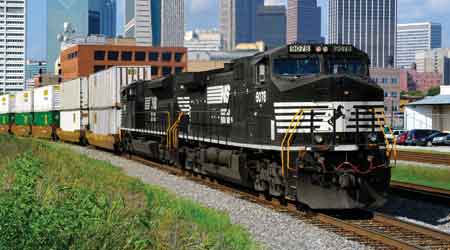
By Julie Sneider, Senior Associate Editor
For the past two years, Norfolk Southern Corp. Chairman, President and Chief Executive Officer Jim Squires has ventured into the field at least once a month to visit the Class I’s customers.
At each visit, he takes with him two or three NS execs to listen and learn. After a tour of the facilities, Squires & Co. sit down for a conversation with the customer’s leaders. The NS team wants to know: How is the Class I doing when it comes to serving them? How can service be improved? How can NS help customers grow?
Typically joining Squires on those trips are Executive Vice President and Chief Marketing Officer Alan Shaw and EVP and Chief Operating Officer Mike Wheeler. EVP and Chief Information Officer Cindy Earhart often attends the meetings, as well.
“We’ve made a concerted effort to better understand our customers’ service requirements since I became CEO,” says Squires, who succeeded Wick Moorman after his retirement in June 2015. “We visit a customer’s facility to see our service first hand and get feedback. We learn a lot from those trips.”
A few themes have emerged from those dozens of visits — themes that NS has incorporated into its five-year strategy to streamline operations, drive profitability, grow traffic and revenue, and enhance shareholder value. The strategic plan, which Squires has taken on the road to pitch to the investment community as well as customers, is designed to position NS for even tighter competition in the eastern U.S. freight-rail market. That focus is especially fitting now that main rival CSX has brought in Hunter Harrison as CEO to overhaul its operations with his “precision railroading” philosophy.
Getting there starts with superior service. And through their monthly visits with customers, NS execs have gained a better understanding of how customers define “service excellence” and performance by the railroad, according to Squires.
“Train speeds and terminal dwell are the two most common metrics that railroad people use to assess railroad performance,” he says. “We manage and keep a close eye on those, but they are not customer-service metrics. What the customer wants to know is, ‘When will my freight be available at the dock or at the terminal for me to pick up?’ And that is more than the sum of train speeds and terminal dwell.”
Pillars of the plan
Improving service is one of the “pillars” that make up the strategic plan, which NS officially rolled out in early 2016 after a six-month evaluation of the company’s business model. Squires initiated and led the evaluation, and NS’ senior management team and board assisted in developing it.
In addition to service, the strategy will address improvements in safety; stewardship, which encompasses productivity and efficiency of employees and assets; and growth. Ultimately, the company aims to achieve annual savings of $650 million and an operating ratio of less than 65 by 2020.
NS execs have credited the plan’s implementation for progress made last year and so far this year. The company wrapped up 2016 — the strategic plan’s first full year — by cutting expenses in all areas of operations to achieve $250 million in annual savings, which surpassed the year’s $130 million target. In 2016, income from railway operations and net income each grew 7 percent year over year, driven by an 11 percent decrease in operating costs, and earnings per share climbed 10 percent.
For all of 2017, NS expects to achieve at least $100 million in annual savings, which would push the company beyond halfway toward its $650 million goal. The Class I posted record results in the first quarter for operating ratio (70 percent), income from operations ($773 million) and earnings per share ($1.48) — which, to Squires, “demonstrate the efficacy of our strategic plan, under which we are enhancing our service quality and network performance while driving significant efficiency improvements,” as he told analysts during the Q1 earnings call on April 26.
“Our focus on providing a superior service product has positioned us for growth and, coupled with our cost discipline, has contributed to a solid start to the year,” he said at the time.
Reductions across the board
Workforce reductions — which occurred last year in the transportation, mechanical and engineering departments, and among management — make up the largest component of the $650 million in anticipated savings, NS senior execs say.
By 2020, the railroad aims to have a total 2,000 fewer employees than it did when the strategic plan was launched. As of early June, NS had 2,300 fewer employees than it did in early 2016, but the company expects to add 300 new jobs by 2020 to accommodate volume growth. NS currently employs about 27,500 people.
Other cost reductions are divided among material savings, as a result of more efficiently using locomotives and freight cars; purchased service savings; and fuel efficiencies, NS execs say.
Some of the company’s cost-cutting last year came from consolidating its three regions to two, and reducing its divisions from 11 to 10. Low-volume yards were idled, such as the one in Knoxville, Tennessee, where 135 positions were cut in 2016; and DeButts Yard in Chattanooga, Tennessee, where 74 positions were eliminated in May.
Trimming rail lines, fleet size
Also included in cost reductions: NS has “rationalized” 1,000 miles of secondary lines and last year trimmed its locomotive fleet by 150 units, with plans to remove another 150 units this year.
Under the strategic plan, locomotives removed from active service typically will go into storage and serve as a “surge” fleet that can be re-activated to handle increases in traffic volumes, company officials say. Creating a surge fleet gives the railroad the flexibility to respond to changing business conditions without having to purchase new locomotives. Older units that are no longer needed for the surge fleet typically are sold. Leasing companies sometimes purchase the locomotives, especially ones that could be used in yard or local service. If the locomotives are older than 25 years, often times the only interested buyers are metal scrap companies.
“Our locomotive assets are being used as efficiently as they can,” says COO Wheeler. “That’s also helped give us better fuel efficiency — 2016 was our most fuel efficient year on record and we’re on track to set another fuel efficiency record in 2017.”
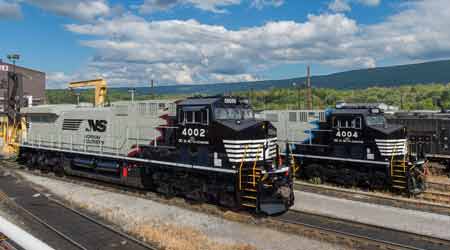
The railroad also is investing in new equipment this year and has embarked on a program to convert a large fleet of DC locomotives to AC motive power over the next several years. By the end of this year, NS will convert 75 Dash 9 locomotives from DC to AC traction. Starting in 2018, NS plans to convert 500 Dash 9s over the next five years.
Additionally, NS is evaluating its freight-car fleet with an eye toward reducing the number and types of cars used.
While cutting costs and improving efficiency are crucial steps in the strategic plan, so is growing revenue and volume. Achieving all those goals requires a balancing act of sorts.
“In order to serve our customers and to grow, we must have a certain level of resources,” says Squires. “The balance comes in by being good stewards of our resources and not having more than is necessary to serve our customers.”
Flexibility is key
The plan has to be flexible in order to respond appropriately to economic headwinds and industry trends. While the financial targets are definite, the way in which the company reaches them may vary over the long term, says CMO Shaw.
For instance, the 2016 economy didn’t improve as hoped, so NS focused on efficiency and improving service, he says.
“This year, the economy is doing a little bit better. And based on our really good service product, we’re able to attract new business and grow,” says Shaw. “We’re still being productive with our assets: We’ve announced productivity savings of $100 million this year. And there you can see the flexibility. The plan delivered financial results in a difficult economy last year and in a good one this year.”
With a stronger economy in 2017, NS is witnessing strength in several different markets. In the first quarter, overall volumes climbed 5 percent compared with 2016, reflecting growth within the Class I’s major commodity categories of coal, intermodal and merchandise. As a result, Shaw is optimistic about the prospects for growth. Under the strategic plan, the railroad will continue to invest in its core network — not to “put new dots on the map,” but in ways that will improve service and fuel new business, he says.
“In the past, we put new terminals in place [to build] our intermodal network and develop corridor strategies,” explains Shaw. “Now, our focus is on filling up those terminals and corridors.”
NS’ network touches more than half of the nation’s population, manufacturing and energy consumption, Shaw notes. So, growing volume will center on service quality.
“We can win or lose business based on service in every business line we handle, whether that’s intermodal, grain or box car,” he says. “What we’re really looking for is growth that complements our network.”
Among the ways the railroad hopes to attract business growth is by converting more truck business to rail. The Class I also is reinvigorating its industrial development program to help its customers grow their own businesses along NS lines and in its corridors.
Regarding intermodal, NS could capitalize on economic opportunities as consumer spending continues to rise and truck capacity tightens. Additionally, company officials anticipate benefits from bigger ships and more ports of call at newly expanded ports along the eastern U.S. coast. In fact, NS’ Heartland Corridor strategy was designed partly to address more port activity from the East Coast, says Shaw. On the Heartland, NS moves freight from the Port of Virginia to points in the Midwest.
Working relationships
To that end, the Class I has been working with its port partners over time to “make sure we have a good service product and the right equipment in place to handle that business,” adds Shaw.
Both NS’ Heartland and Premier corridors are gateways into and out of Chicago. On the Premier Corridor, the railroad moves freight primarily between the Midwest to the Mid-Atlantic and Northeast, with connector points farther south.
NS’ other corridors are the Crescent, where freight moves from the Southeast to the Northeast; the Meridian Speedway, a joint venture with Kansas City Southern where freight moves from points in the South to the Southeast; and the Pan Am Southern, a joint venture with Pan Am Railways where freight moves between Albany, N.Y., and Boston.
When it comes to growing volume, increasing efficiency and improving safety, NS also has integrated into its plan a network-wide digital strategy. For example, the Class I is developing new digital tools and apps to make it easier for customers to order cars or place shipments with the railroad. One new technology uses algorithms to determine the most efficient routes for distributing empty cars to customers.
NS also is modernizing and updating its “accessNS” e-commerce portal that allows customers to directly manage their orders and shipments.
“We’re investing in accessNS to allow the customer to see where their shipments are, find shipments that are behind schedule and proactively receive notifications from us when that happens,” says Shaw. “It will help them with delayed shipments; it will help them with billing and it will help them release empties.”
What’s more, the Class I is beta-testing a new system designed to optimize equipment utilization and distribution to customers. Such efforts are being pursued to help customers get their shipments processed, moved and delivered faster, easier and with more transparency. That effort has required unified communication internally and externally with NS’ partner short lines.
“What has changed over the last 18 months is that we are looking beyond just the borders of our railroad in working with our customers,” says Shaw. “We are looking at how the customer views us and what the customer needs. We’re recognizing that we are part of a transportation ecosystem; we can’t just turn the [the shipment] over to another railroad or short line and say it’s not our problem anymore.”
To improve train crew management, NS recently signed on with software company PS Technology to develop an automated system that will be phased in throughout the railroad’s network.
Incorporating the software with the railroad’s operating and data platforms is expected to cut costs and streamline train crew management and payroll, NS officials say.
Also addressed in the long-term plan: Safety. As railroad industry professionals often say, “Safety is priority No. 1,” and that’s the case with NS’ strategy.
“Safety is the cornerstone of our company and it always will be,” says Wheeler. “For employee safety, the key driver is rule compliance. Every employee wants to work in an environment where people are following the rules. Our supervisors have a responsibility to make sure that’s the case.”
New campaigns for safety
To strengthen the safety culture at NS, the company has created two new internal campaigns. One is branded “I Am Going Home,” and is intended to capture employees’ emotions in ways that will serve as a constant reminder to work safely so that they return to their family each day.
The second campaign, called “Tell Me,” encourages workers to speak up if they see a fellow employee performing a task in an unsafe manner.
To boost safety awareness at the community level, NS in 2016 launched its safety train, which this year will travel to 23 towns to give first responders free training on how to respond to a railroad accident, especially those that involve hazardous materials. The train is composed of a 273-ton locomotive, two box cars converted into 30-seat classrooms, four styles of tank cars — DOT-105, DOT-111, DOT-112 and DOT-117 — and two 89-foot flat cars used to transport intermodal containers.
By the time 2020 rolls around, NS leaders believe the Class I will be a safer, more efficient, competitive and profitable railroad.
“We’re really excited about the opportunities and the progress we’re making,” says Squires.
As for the competition, does Squires see an opportunity for NS to benefit from the organizational restructuring underway at CSX?
“The way we see things, the greatest opportunity for market share or revenue [growth] is from diverting truck freight to the railroad,” Squires says. “That’s our focus. As long as the freight fits well with our network and we can meet the customer’s service needs, and as long as the new business translates into bottom-line growth for us, we are open for business.”
OPERATING RATIOS AND DUELING PHILOSOPHIES
How do industry observers view Norfolk Southern Railway’s long-term strategy?
Robert W. Baird & Co. Inc. analyst Benjamin Hartford believes the company’s five-year plan is sound.
“It’s all oriented to return-on-asset improvement. And I think the steps are an equal-part combination of continuing to realize real pricing, growing volumes GDP-like, and also improving asset velocity and moving margins higher,” he says. “If all that is the case, then it will add value to customers and add value to shareholders.”
But if there’s one dominant metric to judge the plan’s success, Hartford believes it’ll be the operating ratio (OR).
“And now you have Hunter Harrison at CSX, and he’s had success driving down Canadian National’s and Canadian Pacific’s ORs to levels that are unprecedented,” he says.
Hartford notes that while NS has a target of a sub-65 OR by 2020, Harrison is aiming for CSX to reach a sub-65 OR this year. Although he hasn’t yet announced long-term targets, Harrison has endorsed the goal of CSX eventually achieving an OR below 60 percent. As a result, NS will be under pressure to reach an OR below 65 as soon as possible, Hartford says.
With Harrison now running CSX, independent rail industry analyst Tony Hatch views the competition between the two Class Is as the ultimate duel between two railroad management philosophies: precision railroading (which Harrison is implementing at CSX) versus a strategic network or more blended model.
“One is OR-obsessed; the other more growth — and with it op/capex — focused,” Hatch wrote in a Progressive Railroading column in April. “Jim Squires and his team have offered up, in their own reflective if not fiery way, a challenge to the investment community — and to rail shippers. Let’s see now what CSX says and does when Hunter steps off that noon train with his handlers, rapier at the ready.” — Julie Sneider
Keywords
Browse articles on Norfolk Southern Railway CSX Pan Am Railways operating ratio intermodal locomotive fleetContact Progressive Railroading editorial staff.


 2025 MOW Spending Report: Passenger-rail programs
2025 MOW Spending Report: Passenger-rail programs
 Gardner steps down as Amtrak CEO
Gardner steps down as Amtrak CEO
 Guest comment: Oliver Wyman’s David Hunt
Guest comment: Oliver Wyman’s David Hunt
 Women of Influence in Rail eBook
Women of Influence in Rail eBook
 railPrime
railPrime




